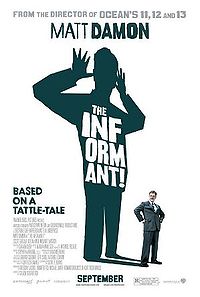
Even as I cracked up through most of “The Informant!” starring Matt Damon, I came away from the movie a tad irked at the way manic depressives are portrayed. Geeze, I thought, hearing all the snickers in the theatre when Mark Whitacre (Damon’s character) was asked if manic-depression ran in his family, I wonder how many people associate bipolar disorder with criminal activity and pathological lies … as if being diagnosed with manic depression zaps a person of his conscience and good judgment.
The stigma is already so thick. Do we really need to poke fun at a condition that is so brutal to manage?
With that in mind, I thought I’d list some common misconceptions of manic depression from John Grohol’s “9 Myths of Bipolar Disorder”… you know, in case anyone out there really thinks we act like Mark Whitacre.
You can get to his original post by clicking here. Here are seven of his myths:
Bipolar disorder has been the focus of attention in recent years, as a new slew of psychiatric medications have been developed to help treat it. Such medications drive pharmaceutical marketing and increased educational efforts surrounding bipolar disorder (for better or worse).
But many myths surround bipolar disorder — what it is, what it means, and how it’s treated. Here’s to busting a few of the most common ones.
1. Bipolar disorder means I’m really “crazy.”
While bipolar disorder is a serious mental disorder, it is no more serious than most other mental disorders. Having a mental disorder doesn’t mean you’re “crazy,” it just means you have a concern that is negatively impacting how you live your life. Left unaddressed, this concern can cause a person significant distress and problems in their relationships and life.
2. Manic depression is different than bipolar disorder.
Manic depression is simply the old name for bipolar disorder. The name was changed to more accurately describe the type of mood disorder it is — someone who experiences swings between two poles of mood (or emotion). Those two poles are mania and depression.
3. I’m feeling better since taking my medications, which means I probably don’t need them any more, right?
Wrong. Once a person starts feeling better because of the medication, they often discontinue taking the medication, leading to an eventual relapse. This is a common problem in the treatment of bipolar disorder and is something professionals like to call “treatment compliance.” This is just a fancy way of saying that a person needs to continue taking their medication as prescribed, no matter how good they may be feeling. It is perhaps one of the most insidious issues in the treatment of bipolar disorder, and leads many people to greater distress than if they just kept taking their medications.
4. There’s no need for psychotherapy in bipolar disorder.
This varies from person to person (just as the need for taking medications does), but this is a myth insomuch that many people and professionals believe that psychotherapy doesn’t help much in the treatment of bipolar disorder. Psychotherapy can be very helpful and effective in the treatment of bipolar disorder, since medications alone can’t teach a person new coping skills or how to deal with feelings of an impending manic or depressive episode. Psychotherapy can help a person with bipolar disorder learn to live with the disorder in their lives without as much stress or upset. While many people with bipolar disorder forgo psychotherapy, it is usually a helpful treatment to consider when first diagnosed.
5. Atypical antipsychotics are only for schizophrenia.
In the U.S. in 1990, a new class of medications was introduced called “atypical antipsychotics.” These newer medications are not used to treat only psychosis (such as that found in schizophrenia), but also a wider range of psychiatric symptoms. One of their approved uses is in the treatment of bipolar disorder in adults. They may also be approved in short time for use in teenagers and children 10 years and older (although they are already sometimes prescribed by doctors for “off label use” in teens and children). So don’t let the name of the class of medications fool you — they treat far more than just psychosis.
6. Atypical antipsychotics have little to no side effects.
Atypical antipsychotics are often the primary drug doctors use to treat bipolar disorder. In the U.S., the Food and Drug Administration has determined that such drugs are both safe and effective for this use. However, like all medications, atypical antipsychotics have their own set of risks and side effects.
These medications have a different side effect profile than the medications they replace. While initially marketed as a “better” side effect profile, research since 1990 has shown that the side effects they do produce in many people can be just as worrisome as older medications. Chief among the typical side effects are weight gain and metabolism problems, which can be precursors to type 2 diabetes, increased risk of stroke, and heart problems (including an increase in cardiac arrhythmias which can lead to sudden death).
7. I may just have depression.
Many times, bipolar disorder mimics clinical depression, because one of the primary symptoms of bipolar disorder is clinical depression. Up to 25 percent of people who have bipolar disorder are initially misdiagnosed with depression. Why does this occur? Because many people first go to their primary doctor for a diagnosis, and primary doctors do not always ask enough questions to make the proper diagnosis. This can occur with mental health professionals who also fail to probe enough when a person presents with clinical depression in their office.
An incorrect initial diagnosis can lead to incorrect treatment, such as the prescription of antidepressant. Generally, antidepressants are not used in the treatment of bipolar disorder, and in fact, can make the disorder worse in the person. So if you’ve ever had an episode of increased energy for no particular reason (not because you just drank a liter of Coke), make sure you share that information with your mental health professional.
* Click here to subscribe to Beyond Blue and click here to follow Therese on Twitter and click here to join Group Beyond Blue, a depression support group. Now stop clicking.

